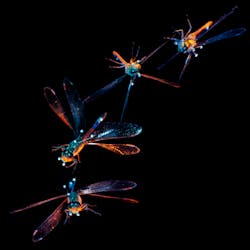The flight maneuvers of dragonflies could serve as a blueprint for drones and other small aerial vehicles. This has the potential to enhance efforts such as building inspections, as well as search and rescue and other such emergency efforts.
Dragonflies instinctively and frequently perform upside-down backflips, called pitching, to right themselves from upside-down positions in the air after being thrown off balance. Researchers at Imperial College London (London, UK) used high-speed cameras to recreate that.
“Engineers could take inspiration from flying animals to improve aerial systems,” says senior author Dr. Huai-Ti Lin of the Imperial College Department of Bioengineering. “Drones tend to rely heavily on fast feedback to keep them upright and on course, but our findings could help engineers incorporate passive stability mechanisms into their wing structure.”
In their study, the researchers were able to capture darter dragonflies’ movement after attaching each with tiny magnets and motion tracking dots (similar to those used in CGI imagery).1 Each dragonfly was attached to a magnetic platform—some were faced up, as normal, and others were attached upside-down, all with variations in tilt, and then “released into a freefall.” According to the study, the motion-tracking dots provided 3D models of the insects’ movements.
Those dropped from an upside-down position somersaulted backwards into the right-side-up position. Some of the dragonflies were unconscious—they also completed the somersault, just slower. The instinctual response demonstrates passive stability, similar to the flight mechanism that allows airplanes to glide when their engines are switched off.
Also in the study, several other dragonflies were dead. While they did not perform a somersault, their bodies did complete the flipping maneuver when the researchers posed their wings into live/unconscious positions. According to the researchers, “this suggests that the maneuver relies on both muscle tone and wing posture, which is inbuilt in the dragonfly as a passive response rather than an active control.”
“Passive stability lowers the effort requirements of flight, and this trait likely influenced how dragonfly shapes evolved,” says Dr. Sam Fabian, a postdoctoral research associate in Imperial College’s Department of Bioengineering and lead author of the study. “Dragonflies that use passive stability in flight are likely to have an advantage, as they use less energy and are better able to recover from inconvenient events."
The researchers are continuing to investigate dragonflies’ flight biomechanics and will also look at how the passive effects impact their active vision and guidance strategies relating to issues such as “obstacle avoidance,” which could aid in the future design of small drones.
REFERENCE
1. S. T. Fabian, R. Zhou, and H. Lin, P. Roy Soc. B–Biol. Sci. (2021); doi/10.1098/rspb.2020.2676.

Justine Murphy | Multimedia Director, Digital Infrastructure
Justine Murphy is the multimedia director for Endeavor Business Media's Digital Infrastructure Group. She is a multiple award-winning writer and editor with more 20 years of experience in newspaper publishing as well as public relations, marketing, and communications. For nearly 10 years, she has covered all facets of the optics and photonics industry as an editor, writer, web news anchor, and podcast host for an internationally reaching magazine publishing company. Her work has earned accolades from the New England Press Association as well as the SIIA/Jesse H. Neal Awards. She received a B.A. from the Massachusetts College of Liberal Arts.
